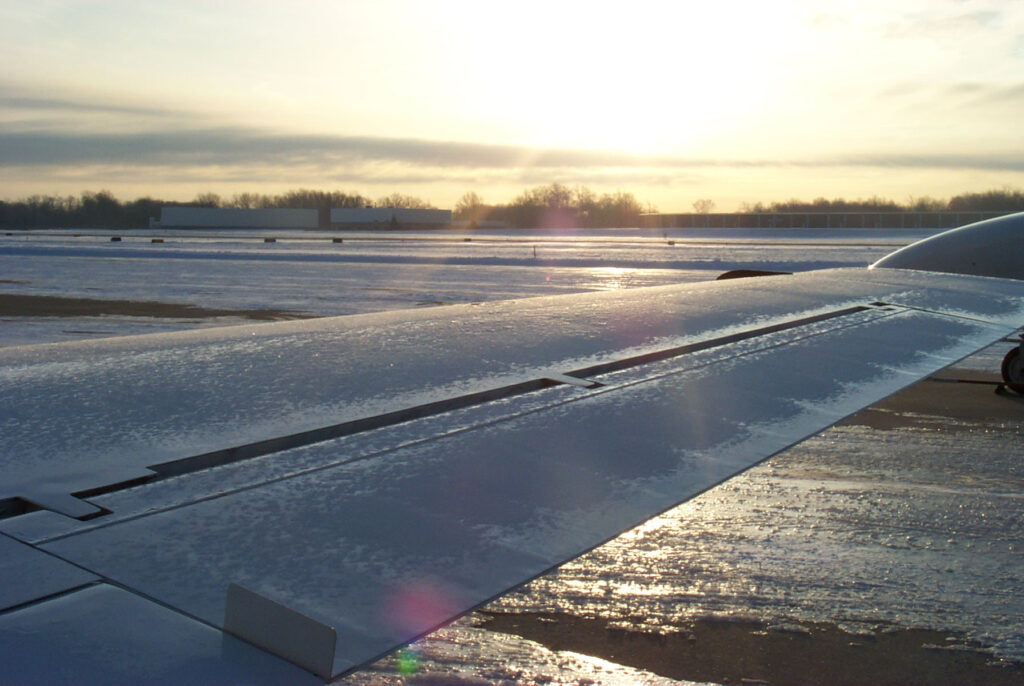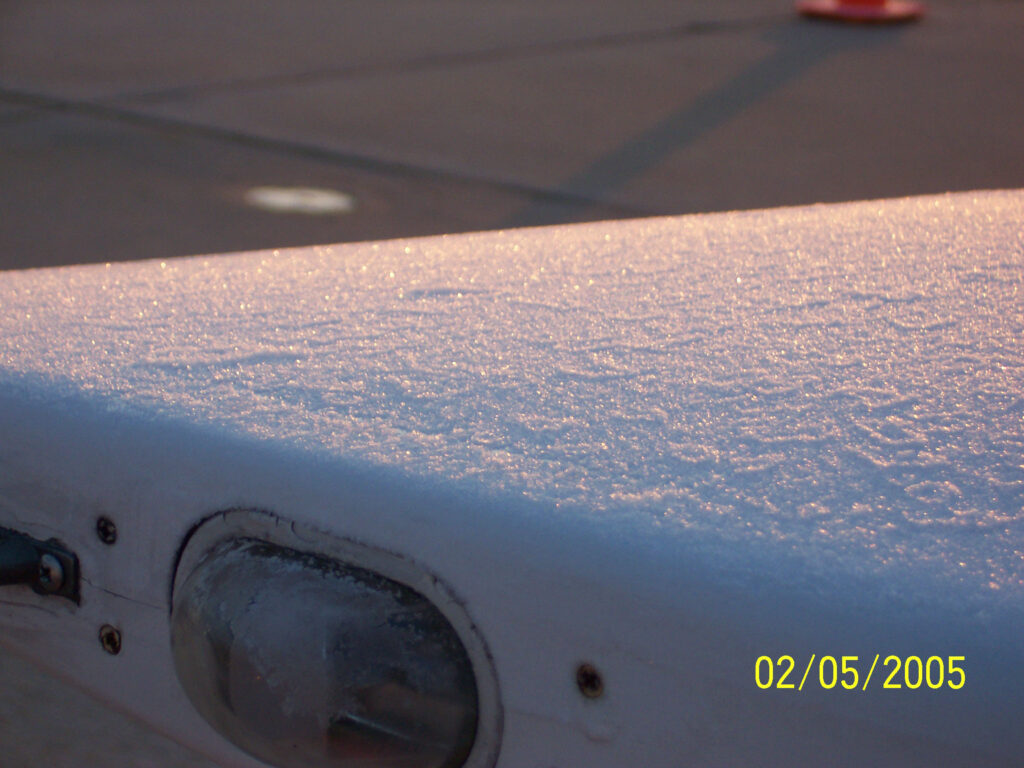It’s officially fall and most of the lower 48 will begin seeing nights with frost if they haven’t already. Frost can greatly disrupt the airflow over your wings and horizontal and vertical stabilizers.
Case Study (Accident Number: LAX04FA064)
On December 8, 2003, about 0655 Pacific standard time, an Iniziative Industrali Sky Arrow
650 TC, N14XL, collided with terrain during takeoff at the Placerville Airport, Placerville,
California. The airplane was owned and operated by the private pilot under the provisions of
14 CFR Part 91.
The pilot’s wife stated that he had called her about 0650 to say that he was preparing to depart for Palo Alto, California. About that time a witness reported seeing a red and white airplane with a pusher propeller taxiing to the runway. The closest meteorological recording station was an AWOS-3 (Automated Weather Observation System) located at Auburn, California, which is about 20 miles northwest of Placerville. At 0630, the temperature was recorded as 03 C, the dew point 0 C, and the sky was clear. The Federal Aviation Administration (FAA) inspector who responded to the accident lives 8 miles from the Placerville airport and reported that there was frost on his outdoor furniture that morning. A California Highway Patrol pilot stopped by the Placerville airport around 0510, and noted that the top of the wings of his airplane and others had frost and ice on them. The Placerville Airport Manager noted that there was frost on his truck the morning of the accident.
At about 1100, a pilot arriving into Placerville Airport noticed an airplane off the runway to the south. He reported it to the airport operations manager. The manager located the airplane and notified rescue agencies. No reports of an Emergency Locator Transmitter (ELT) beacon signal were received.
The first responder to the accident reported that large water droplets covered the tops of the wing. The wreckage was located approximately 1,450 feet down the runway and 140 feet to the south on downhill sloping terrain. Approximately 1,250 feet down the runway, a 21-foot-long ground scar resembling tire tracks was located on a grass shoulder area on the south side of the runway. The track was angled away from the runway and ran in a direction pointing toward the airplane wreckage. The tracks originated about the middle of a grass shoulder area that parallels the runway. Between and forward of two narrow parallel tracks was an elongated and much wider area of disturbed earth that approximated the dimensions of the aircraft’s nose. Examination of the wreckage found no evidence of a preimpact malfunction or failure of the control system or power plant. Following the recovery of the wreckage, the engine was test run successfully while still installed in the airframe. Using the airplane flight manual the takeoff ground roll under the accident ambient conditions was calculated as 912 feet and the distance to clear a 50-foot obstacle was 1,556 feet. The normal takeoff flap configuration, as described in the Flight Manual, is the 10-degree setting. The flaps were found in the retracted position with the cockpit control in a matching setting.
The National Transportation Safety Board determines the probable cause(s) of this accident to be: the pilot’s failure to fully remove an accumulation of ice and frost on the wings, which led to an inadvertent stall/mush and collision with the ground. A factor in the accident was the pilot’s failure to correctly configure the flaps for takeoff.
These types of accident reports are troubling to read because they are preventable. While we can’t go back in time to remind this pilot to remove the frost from his wings, we can use it as a stark reminder for all pilots to do so.
How Does Frost Form?
Frost forms when dew is present and the surrounding air is colder than freezing. Surfaces, such as a wing or leaves on a tree, may cool at night to a temperature at or below the dew point of the adjacent air, causing dew to accumulate on the surfaces. If the temperature continues to drop below freezing, the liquid dew will turn to ice. However, if the dewpoint is 0°C (32°F) or below, the water vapor turns directly to ice, completely bypassing the liquid state (deposition), resulting in frost. Dew instead changes from water vapor to liquid to ice, which contributes to visual differences between frozen dew and frost. Frozen dew is easily distinguished from frost because frozen dew is hard and transparent while frost is white and opaque.
Not every surface outside may have frost because some objects absorb abundant heat during the day, lose it slowly during the night, and cool below the dew point only in extreme cases. For example, a portion of your wing could have been in direct sunlight (and therefore heat) all day while other parts of the wing were shaded by a tree. In this case, parts of your wing could, in theory, have frost while other areas of your wing or aircraft may not have frost. This is why thin metal airfoils, which lose heat more easily, are especially vulnerable to frost formation.
When Is Frost Likely to Occur?
Frost is likely on a clear night when the temperature-dew point spread is 2°C (4°F) or less and is decreasing and the dew point is lower than 0°C (32°F).
Can Frost Occur in Temperatures Above Freezing?
Yes. On nights with little to no cloud cover, heat from objects on earth radiates to the sky. As the night progresses, this cooling increases as objects continue to radiate thermal energy. Because heat is radiating to outer space, objects lose heat and the surrounding objects, such as the dirt and rocks under grass, often cannot replenish heat fast enough.
Also, weather thermometers are not often located at ground level, but rather several feet in the air. Because the thermometers are higher and cold air sinks, often the air at ground (or wing) level is colder than the official temperature. For this reason, you may even find frost at official temperatures as high as 5.4°C (or 42°F).
Why is Frost a Flight Hazard?
Wind tunnel and flight tests have shown that frost, snow, and ice accumulations no thicker or rougher than a piece of coarse sandpaper on the leading edge or upper surface of a wing can reduce lift by 30% and increase drag up to 40%. Larger accretions can reduce lift even more and can increase drag by 80% or more. Changes in lift and drag can significantly increase stall speed, reduce controllability, and alter an airplane’s flight characteristics. Thicker or rougher frost, ice, or snow formations will have increasingly adverse effects, with the primary influence being surface roughness location on critical portions of an aerodynamic surface, e.g., the leading edge of a wing. These adverse effects on the aerodynamic properties of an airfoil may result in a sudden departure from the desired flight path without any prior indications or aerodynamic warning to the pilot. Even a small amount of frost on airfoils may prevent an aircraft from becoming airborne at normal takeoff speed. Also possible is that, once airborne, an aircraft could have an insufficient margin of airspeed above stall such that moderate gusts or turning flight could produce incipient or complete stalling. Anytime you choose to take off in an aircraft with a contaminated wing surface, you are technically a test pilot in an aircraft being flown contrary to its design.
How Did Polishing Frost Become a Fallacy?
The practice of making takeoffs with frost on an airplane, polished to ensure that a smooth surface exists, dates back to at least 1960. A Civil Air Regulations Draft Release addressed the procedure which has evolved into Title 14 of the Code of Federal Regulations (14 CFR) part 91, subpart F; part 125; and finally part 135. FAA guidance regarding this technique appears in Advisory Circular 135-17 which states that “It is recommended that all wing frost be removed by means of conventional deicing process; however, if polished frost is desired, the aircraft manufacturer’s recommended procedures should be followed.” [SAFO 06014]
In February 2010, the FAA removed certain provisions in its regulations that allow for operations with polished frost on the wings and stabilizing and control surfaces of aircraft. The intent was to increase safety by not allowing operations with polished frost, which the FAA determined increases the risk of unsafe flight. Under the final rule, operators are required to remove any frost adhering to critical surfaces prior to takeoff as specified in 14 CFR 91.527, 125.221, and 135.227.
What Should Pilots Do When Their Aircraft Has Frost on It?
While 14 CFR part 91, subpart F, requires large operators to remove all frost prior to operation but does not have a provision for lighter GA aircraft, we should employ best practices and remove all frost, ice, and snow from the aircraft before flying. Do NOT get fooled by the fallacy that it’s safe to fly after polishing frost. Unless your aircraft manufacturer has data showing this is a safe practice, you should assume it is not safe. Aerodynamics and the laws of physics will not be altered by a note in an operations flight manual.
What Should You Have Learned?
Frost often forms on nights with little cloud coverage and wind when the temperature is less than 5.4°C. Any frost or ice on airfoils can disrupt airflow, increase stall speed, and reduce lift. Polishing or smoothing ice does not reverse these negative aerodynamic issues. Therefore, closely inspect aircraft for frost or ice and remove them from your aircraft before taking off.



